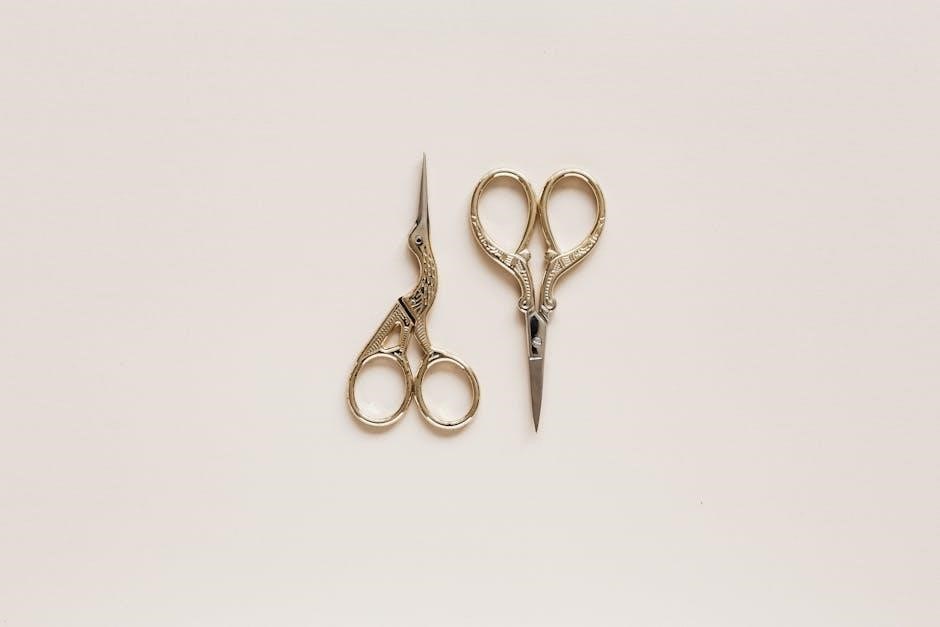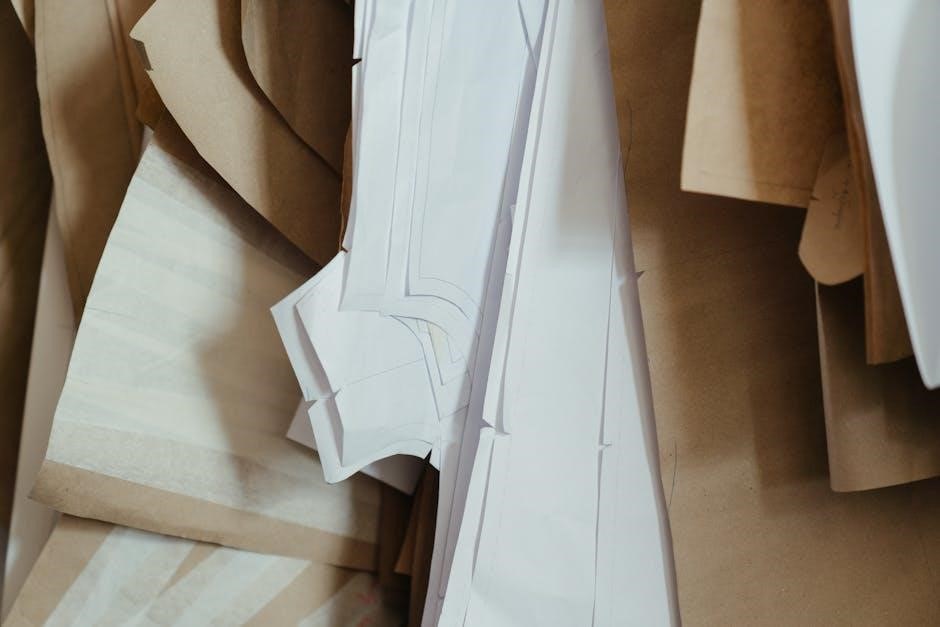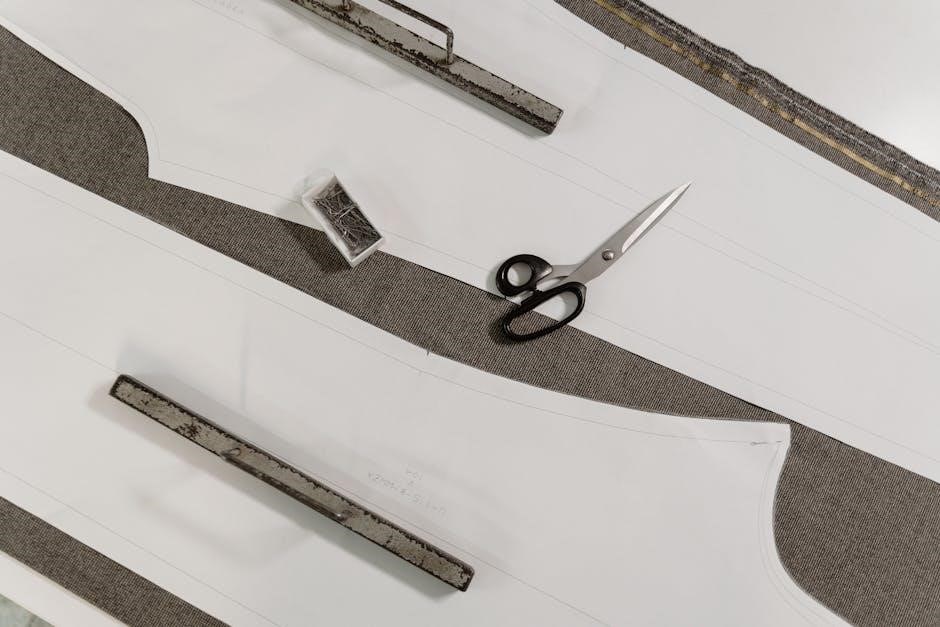Readers Digest’s Complete Guide to Sewing, first published in 1976, quickly became the definitive resource for sewers of all levels, offering comprehensive instruction and guidance.
This invaluable volume covers everything from essential tools and fabrics to advanced techniques and inspiring projects, empowering both beginners and experienced crafters.
The Legacy of the Reader’s Digest Guide
The Reader’s Digest Guide to Sewing has maintained a remarkable legacy since its initial publication in 1976, establishing itself as a cornerstone resource for generations of sewing enthusiasts.
Its enduring popularity stems from a commitment to clear, illustrated instructions, covering all facets of the craft – from fundamental techniques to complex garment construction. The guide’s comprehensive nature, encompassing tools, fabrics, patterns, and projects, made it an indispensable companion for both novice learners and seasoned sewers.
Considered a standard reference, it continues to inspire creativity and skill development within the sewing community, solidifying its place in crafting history.
Who is This Guide For?
The Reader’s Digest Guide to Sewing is thoughtfully designed for a broad audience, welcoming both young adults and seasoned individuals into the world of sewing.
Whether you’re a complete beginner eager to learn the basics or an experienced sewer looking to refine your skills, this guide offers something valuable. Its step-by-step instructions and detailed illustrations make complex techniques accessible, while its comprehensive coverage ensures even advanced crafters will discover new insights.
It’s perfect for anyone desiring a complete, reliable resource for all their sewing endeavors.
Essential Sewing Tools & Equipment
Readers Digest’s guide emphasizes mastering fundamental tools – needles, scissors, measuring devices – and understanding their specific uses for successful sewing projects.
Hand Sewing Needles: Types and Uses
Readers Digest’s guide details a variety of hand sewing needles, each designed for specific fabrics and tasks. Sharp needles are ideal for woven materials, while ball-point needles prevent snagging knit fabrics.
Embroidery needles feature larger eyes for thicker threads, and tapestry needles have blunt tips for counted cross-stitch. The guide explains how needle size correlates with fabric weight; finer fabrics require smaller needles, and heavier fabrics necessitate larger, stronger ones.
Understanding these distinctions ensures neat, efficient hand sewing, preventing damage to materials and achieving professional-looking results.
Machine Sewing Needles: A Comprehensive Overview
Readers Digest’s guide emphasizes the importance of selecting the correct machine needle for optimal sewing performance. Universal needles suit most woven fabrics, while stretch needles are designed for knits and prevent skipped stitches.
Ball-point needles, similar to their hand-sewing counterparts, are crucial for avoiding runs in delicate knit materials. Denim/jeans needles penetrate heavy fabrics with ease, and leather needles feature a wedge-shaped point.
The guide details needle sizes, stressing that finer fabrics require smaller needles, and heavier fabrics demand larger, more robust options.
Scissors and Shears: Choosing the Right Cut
Readers Digest’s Guide highlights the distinction between dressmaking shears and tailoring scissors, emphasizing that shears are designed for cutting layers of fabric, while scissors are better suited for single layers or trimming.
High-quality steel is paramount for maintaining a sharp edge, ensuring clean, precise cuts. The guide advises against using fabric scissors for paper or other materials, as this dulls the blades.
Bent-handle shears offer improved visibility when cutting curves, and pinking shears prevent fabric fraying. Proper care, including regular sharpening, extends the life of these essential tools.
Measuring Tools: Rulers, Tape Measures, and Gauges
Readers Digest’s comprehensive Guide stresses the importance of accurate measurements for successful sewing projects. A flexible tape measure is crucial for body measurements and curved edges, while a clear plastic ruler is ideal for straight lines and pattern adjustments.
Seam gauges and hem markers ensure consistent seam allowances and hem depths. The guide details how to use these tools effectively, emphasizing precision as key to garment fit.
Yardsticks are useful for measuring long lengths of fabric, and a hip curve ruler aids in pattern drafting and alteration for a professional finish.

Understanding Fabrics
Readers Digest’s Guide thoroughly explores fabric types, differentiating between natural fibers like cotton and silk, and synthetics such as polyester and nylon.
Understanding fabric grain – woven versus knit – is essential for proper cutting and garment construction.
Natural Fibers: Cotton, Linen, Silk, and Wool
Readers Digest’s comprehensive Guide dedicates significant attention to natural fibers, detailing the unique characteristics of each. Cotton, prized for its breathability and affordability, is ideal for everyday garments and projects. Linen, derived from flax, offers exceptional strength and a distinctive texture, perfect for warm-weather clothing.
Silk, renowned for its luxurious sheen and delicate drape, elevates special occasion wear. Finally, wool provides warmth and resilience, making it suitable for outerwear and cozy knits. The Guide explains how each fiber behaves during sewing, washing, and wearing, empowering sewers to make informed fabric choices.
Synthetic Fibers: Polyester, Nylon, Acrylic
Readers Digest’s Guide thoroughly explores synthetic fibers, highlighting their distinct advantages. Polyester, known for its durability and wrinkle resistance, is a versatile choice for a wide range of projects, from clothing to home décor. Nylon offers exceptional strength and elasticity, making it ideal for activewear and lingerie.
Acrylic provides a wool-like feel at a lower cost, suitable for knitwear and craft projects. The Guide details how these fibers differ in terms of drape, care requirements, and suitability for various sewing techniques, assisting sewers in selecting the optimal material.
Fabric Grain: Woven vs. Knit
Readers Digest’s Guide dedicates significant attention to understanding fabric grain, a crucial element for successful sewing. It clearly differentiates between woven and knit fabrics. Woven fabrics, constructed with interlacing yarns, possess a distinct grainline – lengthwise, crosswise, and bias – impacting how they drape and cut.
Knit fabrics, created with interlocking loops, offer stretch and require different handling techniques. The Guide explains how to identify grainlines, lay out patterns accordingly, and account for stretch to achieve professional results, preventing distortion and ensuring garment fit.
Choosing Fabric for Different Projects
Readers Digest’s Guide emphasizes that selecting the right fabric is paramount to project success. It provides detailed guidance on matching fabric properties to garment types. Lightweight cottons are ideal for summer dresses, while sturdy denim suits jeans or jackets.
The Guide explains how drape, weight, texture, and fiber content influence the final outcome. It advises considering factors like durability, washability, and intended use, ensuring both aesthetic appeal and practical functionality. Careful fabric selection, as detailed in the Guide, elevates sewing projects.

Sewing Machine Basics
Readers Digest’s Guide details essential machine operation, including threading, stitch selection, and maintenance. Mastering these basics unlocks a world of sewing possibilities for all skill levels.
Threading a Sewing Machine
Readers Digest’s comprehensive Guide meticulously illustrates the often-intimidating process of threading a sewing machine. It emphasizes following the machine’s specific diagram, guiding the thread correctly through tension discs, take-up levers, and finally, the needle’s eye.
The Guide stresses the importance of raising the presser foot during threading to properly open the tension. Detailed visuals demonstrate how to secure the bobbin thread, ensuring a balanced stitch. Proper threading is foundational, preventing skipped stitches and ensuring smooth, reliable sewing performance, as highlighted within the book’s instructional pages.
Basic Sewing Machine Stitches
Readers Digest’s Guide dedicates significant attention to mastering basic sewing machine stitches, starting with the straight stitch – the workhorse of sewing. It details stitch length adjustments for various fabrics and purposes, from garment construction to quilting.
Zigzag stitches are thoroughly explained, showcasing their versatility for finishing raw edges and creating decorative effects. The Guide also introduces buttonhole stitches and stretch stitches, providing clear instructions and diagrams. Understanding these fundamental stitches unlocks a world of sewing possibilities, as emphasized throughout the book’s practical lessons.
Sewing Machine Maintenance
Readers Digest’s Guide stresses the importance of regular sewing machine maintenance for optimal performance and longevity. It provides detailed instructions on cleaning lint and dust from the machine’s internal components, preventing jams and ensuring smooth operation.
The Guide also covers oiling procedures, specifying the correct type of oil and lubrication points. Troubleshooting common issues, like thread breakage and skipped stitches, is addressed with clear explanations. Consistent maintenance, as outlined in the book, guarantees a reliable and enjoyable sewing experience for years to come.

Fundamental Sewing Techniques
Readers Digest’s Guide meticulously details essential techniques like seams, hems, darts, and gathering, providing clear illustrations and step-by-step instructions for garment construction.
Seams and Seam Finishes
Readers Digest’s comprehensive Guide dedicates significant attention to mastering seams and seam finishes, recognizing their crucial role in garment durability and appearance. It thoroughly explains various seam types – plain, French, flat-felled – detailing their strengths and appropriate applications.
Beyond basic construction, the Guide emphasizes the importance of neat seam finishes to prevent fraying and enhance longevity. Techniques like zigzagging, serging, and binding are illustrated with clarity, ensuring even novice sewers can achieve professional-looking results. The book stresses selecting the correct finish based on fabric type and project requirements, contributing to a polished and lasting final product.
Hems: Different Styles and Techniques
Readers Digest’s Guide to Sewing provides a detailed exploration of hems, recognizing their importance in finishing garments professionally. It showcases a wide array of hem styles, from simple turned-up hems to more elaborate blind hems and rolled hems, catering to diverse fabric weights and design preferences.
The book offers step-by-step instructions, accompanied by clear illustrations, for each technique. It emphasizes achieving a neat, even hemline and securing it effectively. Guidance is given on adapting hem widths and choosing appropriate stitching methods, ensuring a flawless finish for any sewing project, enhancing both appearance and garment lifespan.
Darts and Pleats: Shaping Garments
Readers Digest’s Guide to Sewing dedicates significant attention to darts and pleats, essential techniques for achieving a well-fitted garment. The book explains how these shaping elements manipulate fabric to conform to the body’s curves, offering detailed diagrams and instructions for accurate construction.
It covers various dart types – straight, curved, and in-the-round – and pleat styles, including knife, box, and kick pleats. Emphasis is placed on precise marking, careful stitching, and smooth blending of darts and pleats into the surrounding fabric, resulting in a professional and flattering silhouette.
Gathering and Shirring
Readers Digest’s comprehensive Guide to Sewing thoroughly explains gathering and shirring, techniques used to create fullness and texture in fabric. The book details methods for achieving even gathers using basting stitches and multiple rows of stitching, alongside techniques for controlled shirring with elastic.
Illustrated step-by-step instructions demonstrate how to distribute gathers evenly, attach gathered fabric to straight edges, and create decorative shirred effects. The guide emphasizes the importance of thread tension and fabric choice for optimal results, enabling sewers to add dimension and visual interest to their projects.

Patterns and Cutting
Readers Digest’s Guide meticulously covers understanding sewing patterns, accurate measurement taking, and precise fabric cutting for successful garment construction and project completion.
Understanding Sewing Patterns
Readers Digest’s comprehensive Guide to Sewing dedicates significant attention to demystifying sewing patterns, a crucial skill for any aspiring seamstress or tailor. The book thoroughly explains pattern symbols, terminology, and how to select the correct size based on individual body measurements.

It details how to interpret pattern layouts, understand grainlines, and make necessary alterations for a perfect fit. Readers will learn to decipher pattern envelopes, identifying fabric requirements, notions needed, and the finished garment’s dimensions.
The Guide emphasizes the importance of carefully reading all instructions before beginning a project, ensuring a smooth and successful sewing experience.

Taking Accurate Measurements
Readers Digest’s Guide to Sewing stresses that accurate measurements are the cornerstone of well-fitting garments. The book provides detailed, illustrated instructions on how to take precise body measurements, including bust, waist, hips, and inseam. It emphasizes the importance of using a flexible measuring tape and having a helper for back measurements.
The Guide explains how to compare these measurements to pattern sizing charts, recognizing that ready-to-wear sizes often differ from pattern sizes.
It also covers techniques for adjusting patterns to accommodate individual body variations, ensuring a customized and flattering fit for every sewing project.
Cutting Fabric: Layout and Precision
Readers Digest’s Guide to Sewing dedicates significant attention to the crucial step of fabric cutting. It details efficient layout techniques to minimize fabric waste, emphasizing the importance of following the grainline indicated on pattern pieces.
The Guide illustrates how to pin patterns securely to the fabric and use sharp scissors or a rotary cutter for precise cuts. It also advises on cutting multiple layers of fabric simultaneously for efficiency.
Accuracy is paramount, and the book stresses the need to carefully trace pattern markings onto the fabric before cutting.

Advanced Sewing Techniques
Readers Digest’s Guide expertly covers complex skills like installing zippers, creating professional buttonholes, and properly applying interfacing for garment structure.
Working with Zippers
Readers Digest’s comprehensive Guide to Sewing dedicates significant attention to mastering zippers, recognizing their importance in garment construction. It details various zipper types – metal, nylon coil, and invisible – and their appropriate applications.
The Guide provides step-by-step illustrated instructions for installing zippers in different ways, including centered, lapped, and fly front zippers. It emphasizes precise fabric preparation, accurate pinning, and utilizing the correct presser foot for a professional finish.
Troubleshooting common zipper issues, like uneven teeth or sticking, is also addressed, ensuring even novice sewers can confidently incorporate zippers into their projects.
Buttonholes and Buttons
Readers Digest’s Guide to Sewing provides detailed instruction on creating durable and professional-looking buttonholes, covering both hand-sewn and machine-made methods. It explains the importance of interfacing for stability and achieving clean edges.
The Guide illustrates various buttonhole styles, including keyhole and bound buttonholes, and offers guidance on selecting the appropriate size for different button thicknesses. It also demonstrates secure button attachment techniques, emphasizing thread choice and proper knotting.
Furthermore, it addresses troubleshooting common issues like uneven buttonholes or loose buttons, ensuring a polished and long-lasting finish to any sewn item;
Applying Interfacing
Readers Digest’s Guide to Sewing thoroughly explains the crucial role of interfacing in garment construction, detailing its function in adding structure, stability, and shape to fabrics. It clarifies the different types of interfacing – woven, non-woven, and fusible – and their specific applications.
The Guide provides step-by-step instructions on properly applying fusible interfacing, emphasizing the importance of correct temperature settings and even pressure for a secure bond. It also covers techniques for applying sew-in interfacing, ensuring a clean and durable finish.
Understanding interfacing is key to achieving professional results, and the Guide empowers sewers with the knowledge to select and apply it effectively.

Sewing Projects for Beginners
Readers Digest’s Guide offers accessible projects like pillowcases, tote bags, and basic skirts, building confidence and skills through simple, rewarding construction techniques.
Simple Pillowcase Project
Readers Digest’s Guide presents the pillowcase as an ideal beginner project, fostering fundamental skills with minimal complexity. This project typically involves cutting two fabric rectangles – often cotton – to the desired size, considering seam allowances.
The fabric pieces are then joined right sides together along three edges, leaving one short end open for inserting the pillow form. A simple hem is applied to the open end, creating a neat finish.
This straightforward construction introduces basic sewing techniques like straight stitching, seam finishing, and accurate measuring, building a solid foundation for more ambitious endeavors.
Easy Tote Bag Tutorial
Readers Digest’s Guide often features the tote bag as a practical and accessible project for novice sewers. Typically, this involves cutting larger rectangles of durable fabric – canvas or sturdy cotton are common choices – for the bag’s body and handles.
The bag is constructed by folding the fabric in half, right sides together, and sewing along the sides and bottom, leaving the top open. Handles are created separately and securely attached to the bag’s body.
This project reinforces skills like straight stitching, reinforcing seams for durability, and creating functional, everyday items.
Basic Skirt Construction
Readers Digest’s Guide often presents a simple A-line skirt as an excellent beginner garment project. This typically begins with a pattern – understanding pattern markings is key – and careful fabric cutting, paying attention to grain lines.
Construction usually involves sewing side seams, then attaching a waistband. A zipper or elastic is incorporated into the waistband for closure. The skirt is finished with a hem, often a simple turned-up hem secured with stitching.
This project builds skills in pattern reading, accurate cutting, and basic garment assembly.

Resources and Further Learning
Readers Digest’s Guide is complemented by numerous sewing books and vibrant online communities, offering tutorials and a glossary of helpful sewing terms.
Recommended Sewing Books
Beyond the foundational Readers Digest Complete Guide to Sewing, several other books enhance the sewing journey. Vintage editions, like the 1976 publication, remain highly sought after for their detailed illustrations and comprehensive approach.
For modern techniques, explore titles focusing on pattern drafting or specific garment construction. Books dedicated to fabric manipulation, like shirring or pleating, can expand your skillset. Consider resources covering alterations and fitting for a personalized touch.
Don’t overlook specialized guides for quilting, embroidery, or couture sewing, depending on your interests. These resources build upon the Readers Digest foundation, fostering creativity and expertise.
Online Sewing Tutorials and Communities
Supplementing the Readers Digest Guide, numerous online resources cater to modern sewers. Platforms like YouTube host countless tutorials, demonstrating techniques from basic stitches to complex garment construction. Websites offer free patterns and detailed instructions, expanding project options.
Online sewing communities, found on forums and social media, provide invaluable support and inspiration. Share projects, ask questions, and learn from experienced sewers. These platforms foster collaboration and problem-solving.
Blogs dedicated to sewing offer in-depth articles and reviews, keeping you updated on trends and tools. Embrace these digital resources to enhance your skills and connect with fellow enthusiasts.
Glossary of Sewing Terms
The Readers Digest Guide, while comprehensive, utilizes specialized terminology. A glossary clarifies these terms for seamless understanding. “Seam allowance” refers to the fabric extending beyond the stitch line. “Grain” describes fabric’s woven direction, impacting drape and cut. “Bias” signifies a diagonal cut, offering stretch.
“Darts” shape garments by removing excess fabric, while “pleats” add fullness. “Interfacing” provides structure and support. “Gathering” creates texture through bunched fabric. Familiarizing yourself with these definitions, and others within the guide, is crucial for successful sewing.